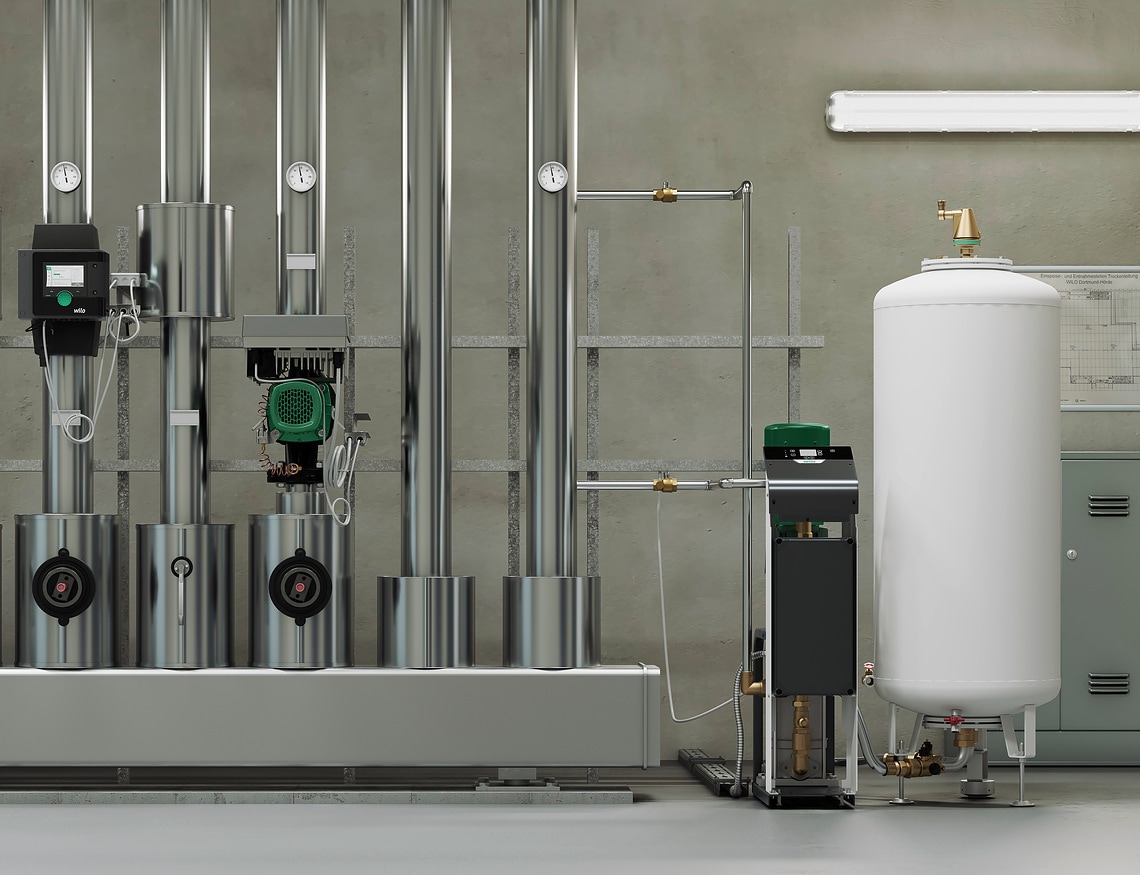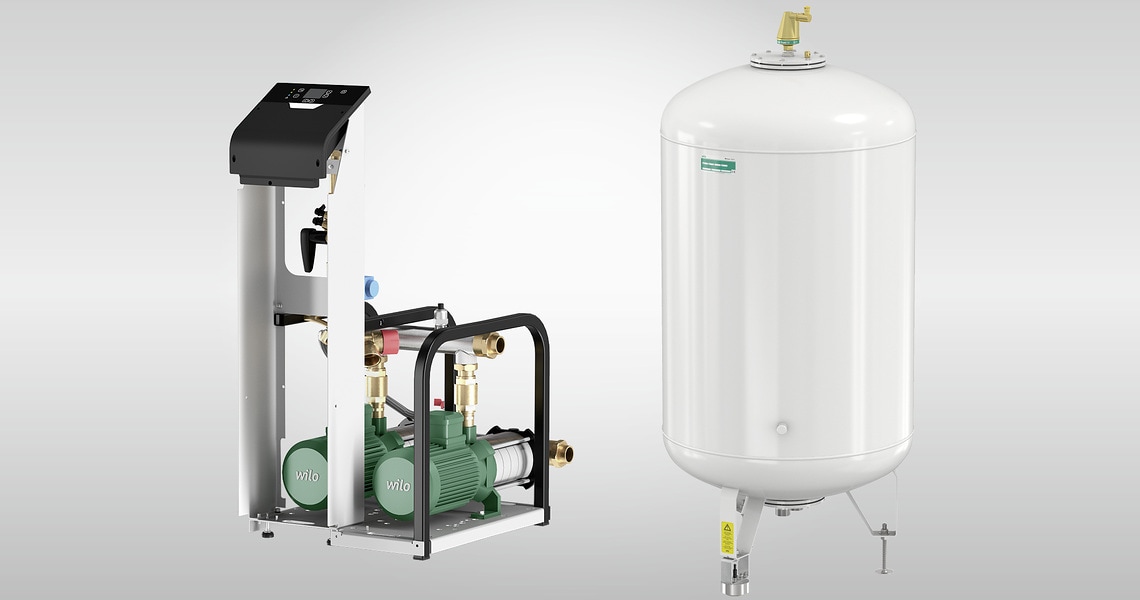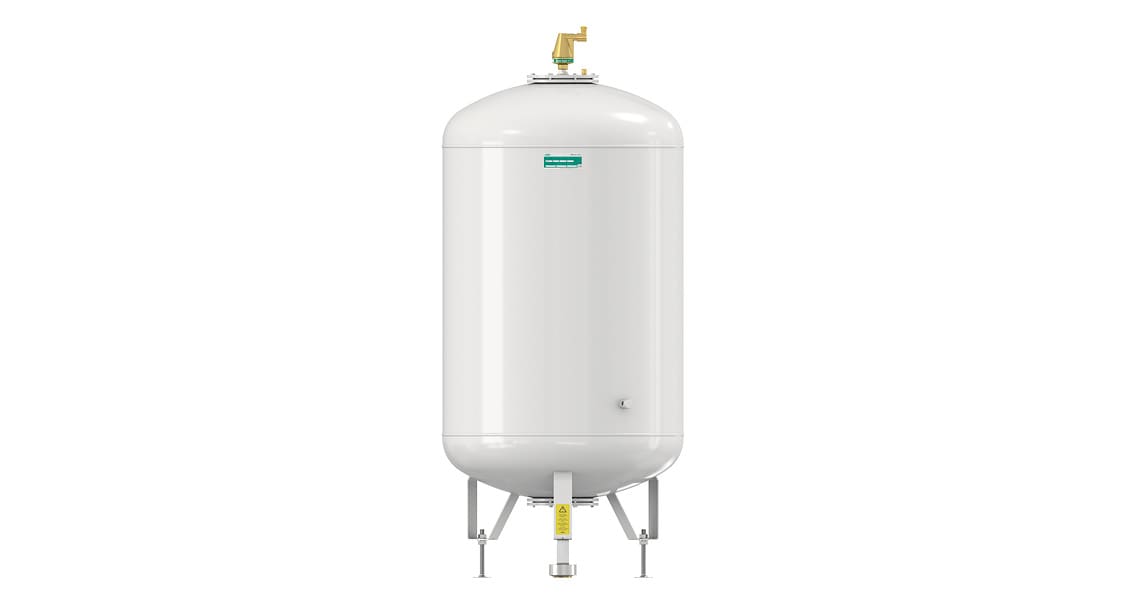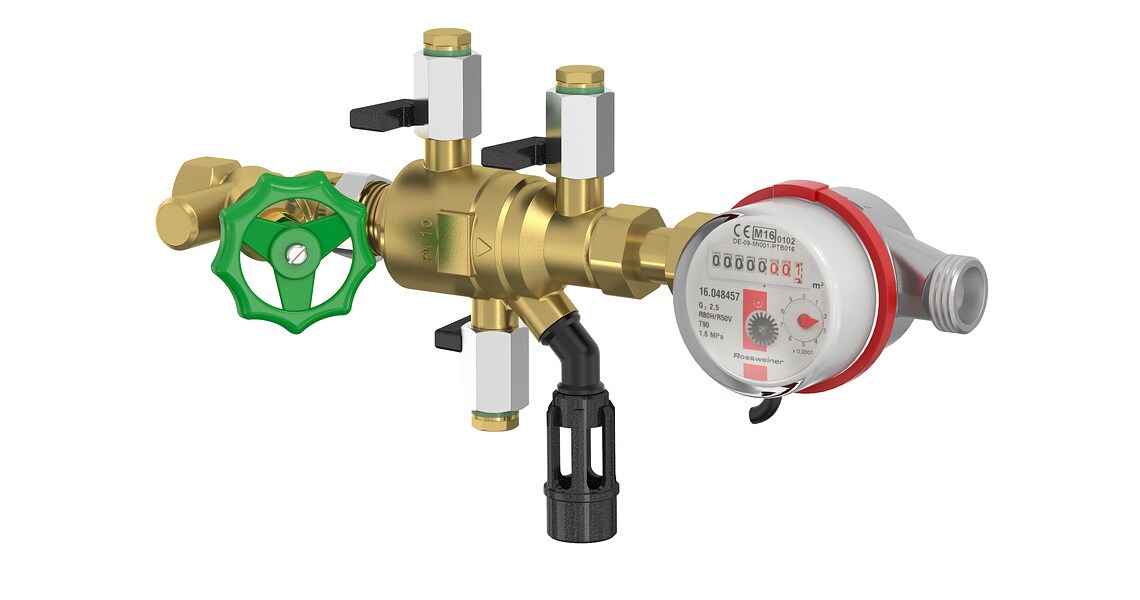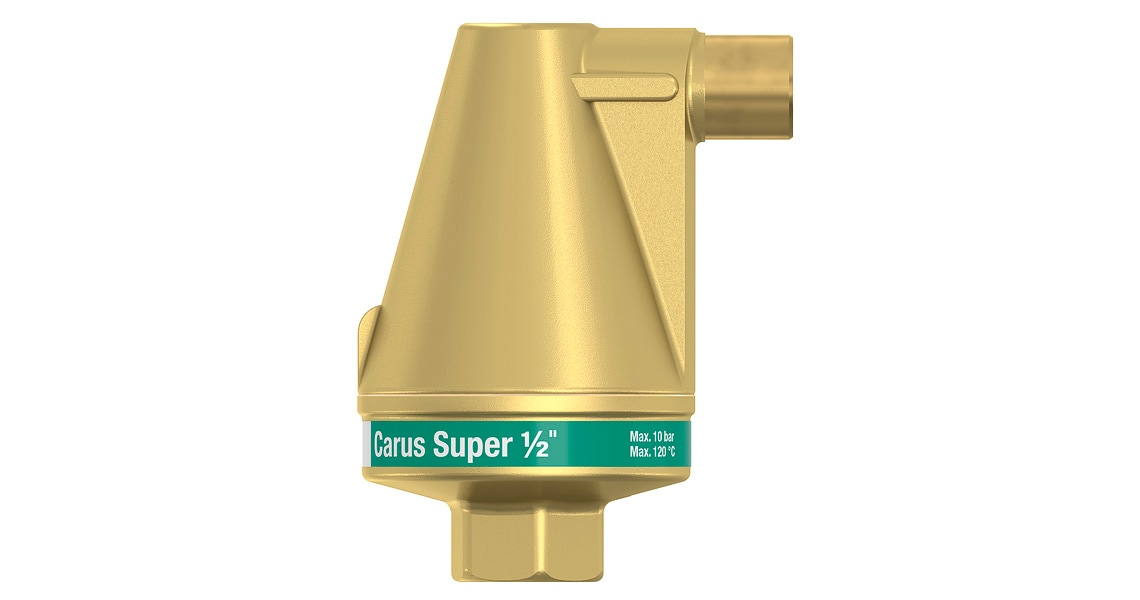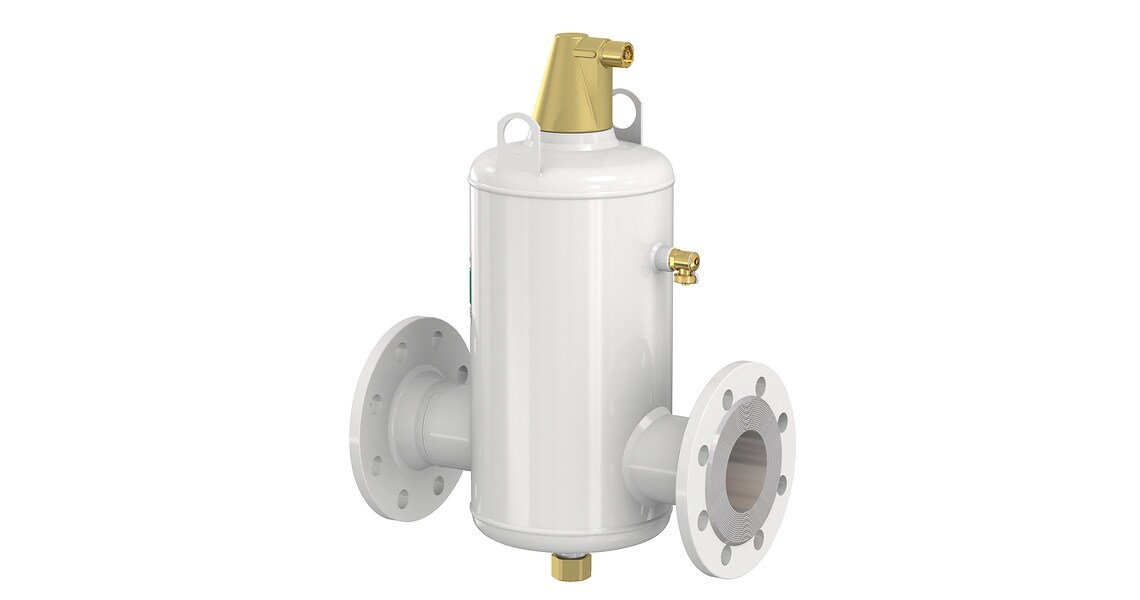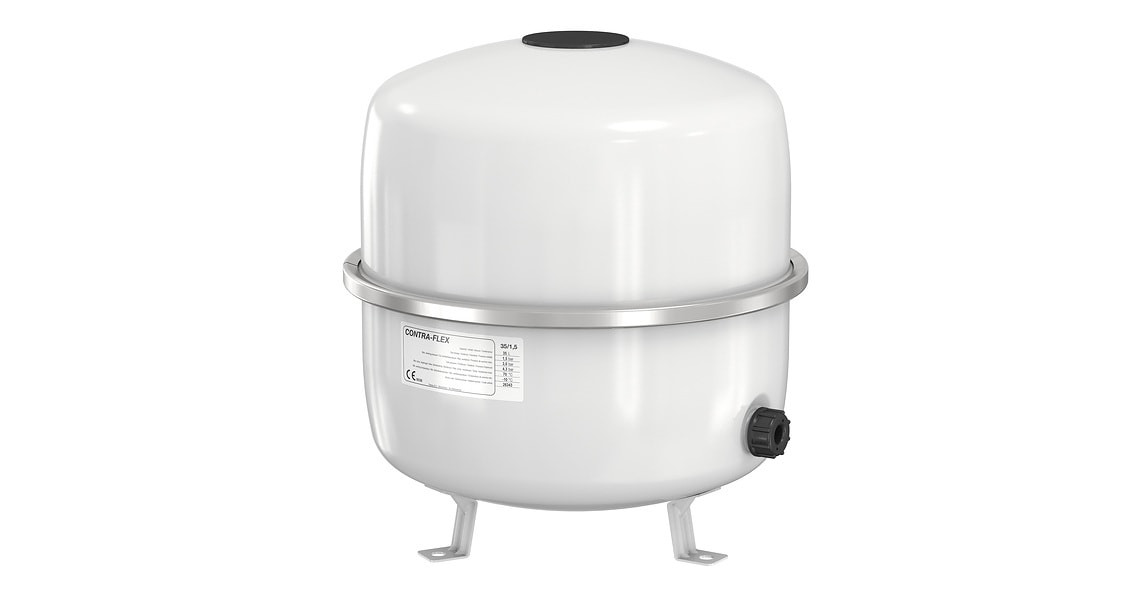Optimum water quality in heating and air-conditioning systems
In closed heating and cooling systems, the treatment of water is instrumental in preventing contamination, corrosion and limescale. These problems can not only cause unpleasant noises in pipes and radiators, but can also lead to energy losses. Inadequate system performance and safety can result in premature replacement of the system or individual components. This is why water quality is now considered a key issue in building services.
Pressurisation
Wilo-Sinum
In heating and cold water systems, the volume of water is increased by heating and decreased again by cooling. In addition, these systems are deliberately operated with overpressure so that vapour bubbles cannot form in critical operating states and at the same time outside air cannot get in.
However, uncontrolled pressure conditions can cause damage to the components of the heating system. This therefore requires optimum interaction between the circulators used, a maximum heating water temperature as well as configuration of pressurisation, replenishment and degassing. Proper selection and design of the components is therefore vital.
Wilo-Sinum MV - main vessel
The unpressurised diaphragm expansion tank for Wilo-Sinum pump modules is designed to store expanding water at atmospheric pressure. The integrated pressure load cell in the foot of the diaphragm expansion tank is used to measure the weight and, above it, the fill level. Up to four vessels of the same size can be used with just one pumping station.
Degassing
Wilo-Tagus
Air is one of the biggest sources of problems in closed systems. Air, and this also includes oxygen and nitrogen, should not be introduced into the system either in daily operation or during maintenance. Once the air is in the system, corrosion occurs, which compromises the durability of the system.
Venting and degassing are a good way to remove air and gas from a system and prevent them from entering during replenishment.
Find out more about the Wilo-TagusThe Wilo water quality systems Wilo-Sinum and Wilo-Tagus ensure continuous pressurisation, degassing and replenishment in closed heating systems (according to EN 12828) and (cooling) systems with cold water. To this end, Wilo uses tried-and-tested, innovative technology in order to remove air, gas and solid particles from the water, whether in a domestic setting or in commercial systems with large heating or cooling water systems.
Replenishment
Wilo-NFE backflow preventer
Modern cooling and heat generators have increased pressurisation requirements. This means that there must always be sufficient water available within the system. With Wilo-Tagus and Wilo-Sinum, water can be replenished manually or automatically at any time. However, according to EN 1717, a requirement for connecting drinking water networks to service water systems is the separation of the systems or backflow prevention.
The Wilo-NFE backflow preventer ensures this up to liquid category 4. For automatic replenishment, a refilling device including a backflow preventer and water meter is generally recommended. This can be connected to the control system by means of a pulse output. Keeping the system logbook required by VDI 2035 is made easier.
Venting, separating micro bubbles and dirt
Water within a system always contains air pockets that may lead to corrosion damage and reduced heat transfer. However, systems where the water is free of air pockets and contamination with dirt particles operate much more efficiently, make less noise and ultimately ensure a longer service life.
Rapid vent: Wilo-Carus
Wilo-Carus is an efficient large rapid vent for expelling air and gas from the system into the environment. It can be used for initial filling or for continuous venting of the Wilo-Sinum and Wilo-Tagus. It should ideally be installed at the highest point in the system. This efficiently facilitates the initial filling during commissioning as well as the refilling after maintenance work.
Find out more about the Wilo-CarusAir and dirt separator: Wilo-Voda
The air and dirt separators from the Wilo-Voda series enable optimum desludging and micro bubble separation of the system taking into account a reduced flow velocity and pressure reduction. An optional magnetic insert also increases the separation efficiency of the Wilo-Voda DIRT.
Find out more about the Wilo-Voda AirFind out more about the Wilo-Voda DirtFind out more about the Wilo-Voda Air/DirtWilo-SiClean Comfort
The Wilo-SiClean separating system can also be used as an alternative to the static separation technology of the Wilo-Voda series. It includes a particle separator supported by a Wilo pump and an integrated control systemThe Wilo-SiClean separating system can also be used as an alternative to the static separation technology of the Wilo-Voda series. It includes a particle separator supported by a Wilo pump and an integrated control system-
Find out more about the Wilo-SiClean ComfortDiaphragm expansion tank
Wilo-MAG
The pressure within a heating circuit can reach such a high level that it causes damage to piping, individual components and even the heat generator. A common and efficient solution for pressure relief for the overall heating and cooling network is therefore provided by diaphragm expansion tanks, which are usually on the suction side of the circulator.
They operate without auxiliary energy and are the means of choice in small to medium-sized heating and cooling systems. A membrane inside the vessel separates the water side of the system from a fixed gas cushion. This in turn adapts the supply pressure to the system to be installed and thus provides additional space for the heating water by compressing it as the heating water expands in the vessel. One advantage of the membrane is the separation of the media of gas and water so that they are not in direct contact with each other to prevent interactions. When configured correctly, the Wilo diaphragm expansion tank always ensures optimum pressure in the heating system.
We have answers to your questions
Our products and services have aroused your interest? Then we are happy to help!
Whether it's creating an offer or editing service specifications, designing different types of equipment, advising on the selection of pumps and switchgear, or just helping with hydraulic and control issues.
Feel free to contact your nearest sales office and make an appointment. We look forward to you!
Find the right contact for your question.